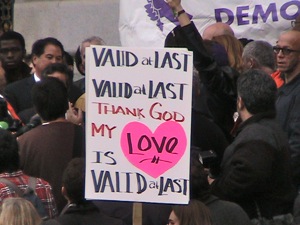One of the ways I sometimes amuse myself on Sunday afternoons is to open the “Sunday Styles” section of the New York Times, and turn to the wedding announcements. I look at the photographs of the wedding couples, and try to figure out who officiated at their wedding.
Because it’s the New York Times, most of the officiants are Epsicopalian priests, Conservative Jewish rabbis or cantors, Catholic priests, or Presbyterian ministers — you know, from the religious groups that are a little higher up, socially speaking. These are the boring couples, because I usually can’t figure out who officiated at their weddings; whether an Episcopalian or a Presbyterian or a Jew or a Catholic officiated, the couples all look pretty much the same. Sometimes you get fooled, though: although there aren’t many Lutherans in the New York Times, when they’re there, they look a lot like Presbyterians.
Then sometimes you get couple who was married by a justice of the peace, or by a friend of the couple who got a one-day license from the state, or by someone who picked up an ordination through the Universal Life Church. I can usually separate these couples out from the previous group; this second group might look a little scruffier (as far as any New York Times wedding couple ever looks scruffy), or a little less conventionally good looking, or their photograph might be unconventional (this week, look for the couple on the bicycles — they had a Universal Life minister).
Once in a blue moon you get a couple who had a Unitarian Universalist minister officiate. I always miss them, because I’m just not expecting them. So imagine my astonishment when I look to see who officiated at the wedding of the nice-looking middle-aged couple. I was expecting a justice of the peace (not many middle-aged couples in the Times, plus he has facial hair) — but not only did a Unitarian Universalist minister officiate, it was someone I know.
Congratulations, Michelle, for finally making into the New York Times. Now you have really arrived.

